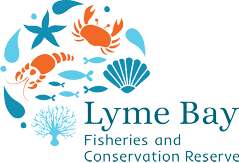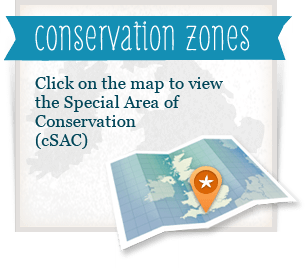Commercial Species
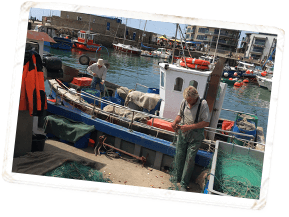 Commercially caught species within Lyme Bay Reserve are many and diverse. Below are some of the species caught.
Commercially caught species within Lyme Bay Reserve are many and diverse. Below are some of the species caught.

Lobster
‘Homarus gammarus’ is a species of clawed lobster from the eastern Atlantic Ocean, Mediterranean Sea and parts of the Black Sea. They have to shed their shells in order to grow and often eat their discarded shells as they are a useful source of calcium. A female can only mate just after she has moulted and once she has copulated her eggs are not fertilised immediately. Instead she can carry the male’s sperm and choose when to fertilise her eggs.
‘Homarus gammarus’ is a species of clawed lobster from the eastern Atlantic Ocean, Mediterranean Sea and parts of the Black Sea. They have to shed their shells in order to grow and often eat their discarded shells as they are a useful source of calcium. A female can only mate just after she has moulted and once she has copulated her eggs are not fertilised immediately. Instead she can carry the male’s sperm and choose when to fertilise her eggs.
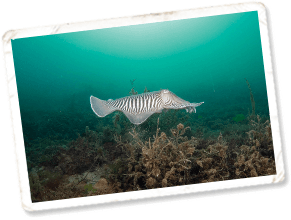
Cuttlefish
‘Sepia officinalis’ are molluscs (so are related to snails and clams) and belong to a group called cephalopods. Cuttlefish have three hearts, two are used to pump blood to the cuttlefish's large gills, and the third heart is used to circulate oxygenated blood to the rest of the body. The blood of a cuttlefish is unusual itself as it is a green-blue colour due to the fact that it uses copper-based hemocyanin to carry oxygen instead of the red iron-containing protein haemoglobin that is found in mammals.
‘Sepia officinalis’ are molluscs (so are related to snails and clams) and belong to a group called cephalopods. Cuttlefish have three hearts, two are used to pump blood to the cuttlefish's large gills, and the third heart is used to circulate oxygenated blood to the rest of the body. The blood of a cuttlefish is unusual itself as it is a green-blue colour due to the fact that it uses copper-based hemocyanin to carry oxygen instead of the red iron-containing protein haemoglobin that is found in mammals.
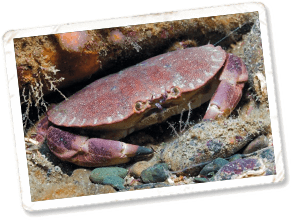
Edible Crab
‘Cancer pagurus’ is easily identified by its large black-tipped toothed pincers and characteristic ‘pie-crust’ edging. It is the largest crab in Britain and is nocturnal. They submerge themselves in the sand during the day and venture out at night to find prey. Their biggest predator is octopus, which sometimes even attack them from inside the cages that fishermen use to catch them.
‘Cancer pagurus’ is easily identified by its large black-tipped toothed pincers and characteristic ‘pie-crust’ edging. It is the largest crab in Britain and is nocturnal. They submerge themselves in the sand during the day and venture out at night to find prey. Their biggest predator is octopus, which sometimes even attack them from inside the cages that fishermen use to catch them.
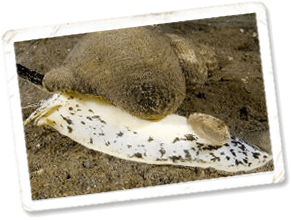
Whelks
‘Buccinum undatum’ is a carnivorous species and will eat crustaceans, mollusks and worms and sometimes even other whelks. They can drill a hole into the shell of their prey with their radula (which is almost like a minutely toothed tongue) or may wrap their foot around the hinged shells of their prey and use their own shell as a wedge to force the shells open. They then insert their proboscis (a tubular sucking organ) into the shell and consume the animal that’s inside.
‘Buccinum undatum’ is a carnivorous species and will eat crustaceans, mollusks and worms and sometimes even other whelks. They can drill a hole into the shell of their prey with their radula (which is almost like a minutely toothed tongue) or may wrap their foot around the hinged shells of their prey and use their own shell as a wedge to force the shells open. They then insert their proboscis (a tubular sucking organ) into the shell and consume the animal that’s inside.
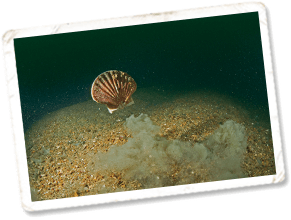
Scallop
‘Pecten maximus’ will take flight from a perceived threat. Scallops can swim by vigorously clapping the two halves (valves) of their shell and thus rapidly ejecting water from their mantle cavity in two jets either side of the shell hinge. They do this briefly, moving only short distances. Scallops are common on the mega-rippled gravel (gravel waves) that cover much of Lyme Bay.
‘Pecten maximus’ will take flight from a perceived threat. Scallops can swim by vigorously clapping the two halves (valves) of their shell and thus rapidly ejecting water from their mantle cavity in two jets either side of the shell hinge. They do this briefly, moving only short distances. Scallops are common on the mega-rippled gravel (gravel waves) that cover much of Lyme Bay.

Seabass
‘Dicentrarchus labrax’ are special in that they are one of the few fish that can survive in both saltwater and freshwater environments. This is because they have a very high tolerance to salinity changes and can survive salt level changes between 0.5-40% salinity. As a species seabass grow slowly and females only become sexually mature from the age of 8-10 years old.
‘Dicentrarchus labrax’ are special in that they are one of the few fish that can survive in both saltwater and freshwater environments. This is because they have a very high tolerance to salinity changes and can survive salt level changes between 0.5-40% salinity. As a species seabass grow slowly and females only become sexually mature from the age of 8-10 years old.
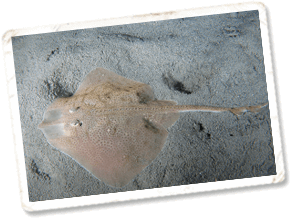
Thornback Ray
‘Raja clavata’ have a flattened and disc-shaped body. The upper surface of this disc and the tail are covered with numerous thorns, which become thickened once the skate is sexually mature, hence the name of the species. The teeth of the ray are arranged into 36–44 rows in the upper jaw. These teeth are pointed in males, but blunter in females and juveniles.
‘Raja clavata’ have a flattened and disc-shaped body. The upper surface of this disc and the tail are covered with numerous thorns, which become thickened once the skate is sexually mature, hence the name of the species. The teeth of the ray are arranged into 36–44 rows in the upper jaw. These teeth are pointed in males, but blunter in females and juveniles.
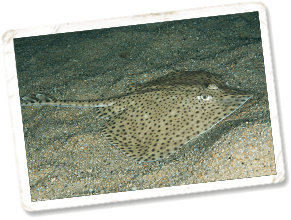
Blonde Ray
‘Raja brachyura’ live over soft and muddy sea beds and have been found at depths of 900m, but usually live at a depth of about 350m. When they are young, blonde rays live in shallower waters and will also come to lay their eggs in rocky, coastal areas in the breeding season. They can have a wingspan of up to 5 feet and have 60-90 rows of teeth.
‘Raja brachyura’ live over soft and muddy sea beds and have been found at depths of 900m, but usually live at a depth of about 350m. When they are young, blonde rays live in shallower waters and will also come to lay their eggs in rocky, coastal areas in the breeding season. They can have a wingspan of up to 5 feet and have 60-90 rows of teeth.
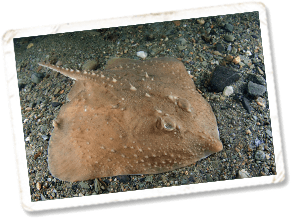
Starry Ray
‘Amblyraja radiata’ is a small ray species, reaching a maximum of around three feet across. They prefer colder waters and so are usually found in the northern parts of the British Isles and in Icelandic and Scandinavian waters. The starry ray is thought to be one of the more abundant ray species in European waters but like all skate and ray species it is highly susceptible to being caught in trawl nets. Sadly it is usually thrown back into the sea as worthless bycatch.
‘Amblyraja radiata’ is a small ray species, reaching a maximum of around three feet across. They prefer colder waters and so are usually found in the northern parts of the British Isles and in Icelandic and Scandinavian waters. The starry ray is thought to be one of the more abundant ray species in European waters but like all skate and ray species it is highly susceptible to being caught in trawl nets. Sadly it is usually thrown back into the sea as worthless bycatch.
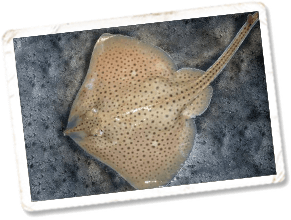
Spotted Ray
‘Raja montagui’ are a small ray species, reaching a maximum of around 5kg, but averaging around half of this size. They rarely leave their preferred deeper water of about 20-30m. They tend to be found towards the west of the British Isles. Spotted ray can often be confused with blonde ray. However, the key distinction is that on the spotted ray the black spots stop before the edge of the wings, whereas in the blonde ray they go right up to the very edges.
‘Raja montagui’ are a small ray species, reaching a maximum of around 5kg, but averaging around half of this size. They rarely leave their preferred deeper water of about 20-30m. They tend to be found towards the west of the British Isles. Spotted ray can often be confused with blonde ray. However, the key distinction is that on the spotted ray the black spots stop before the edge of the wings, whereas in the blonde ray they go right up to the very edges.
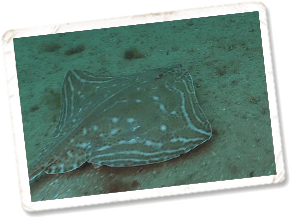
Small-Eyed Rays
‘Raja microocellata’ prefer to hunt around muddy or sandy sea beds and this is because they like to ambush their prey. They bury themselves in the sea bed and then strike their prey (usually small fish) as it passes by. Sometimes they will scavenge on dead fish and are very opportunistic, so will take small marine creatures such as worms and crustaceans when they can.
‘Raja microocellata’ prefer to hunt around muddy or sandy sea beds and this is because they like to ambush their prey. They bury themselves in the sea bed and then strike their prey (usually small fish) as it passes by. Sometimes they will scavenge on dead fish and are very opportunistic, so will take small marine creatures such as worms and crustaceans when they can.
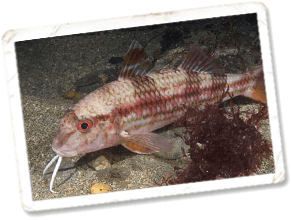
Red Mullet
‘Mullus surmuletus’ are found throughout the Black Sea and the Mediterranean. It’s range extends all the way to the northern coast of Africa and the Spanish, French and Portuguese coastlines. It can also be found in the English Channel and in southern parts of the North Sea. The red mullet has a pair of long chin barbels which are used to find the shellfish, crabs, small lobsters and worms that the fish feed on. They are predominantly scavengers and so will also eat dead fish when given the chance.
‘Mullus surmuletus’ are found throughout the Black Sea and the Mediterranean. It’s range extends all the way to the northern coast of Africa and the Spanish, French and Portuguese coastlines. It can also be found in the English Channel and in southern parts of the North Sea. The red mullet has a pair of long chin barbels which are used to find the shellfish, crabs, small lobsters and worms that the fish feed on. They are predominantly scavengers and so will also eat dead fish when given the chance.
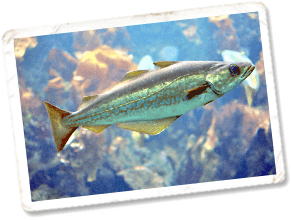
Pollack
‘Pollachius pollachius’ are closely related to cod and have conspicuously large yellow eyes. It is both a solitary and a shoaling species and is most likely to shoal during spawning events. During these events the eggs and sperm are released into the water column and then drift towards shallower coastal waters.
‘Pollachius pollachius’ are closely related to cod and have conspicuously large yellow eyes. It is both a solitary and a shoaling species and is most likely to shoal during spawning events. During these events the eggs and sperm are released into the water column and then drift towards shallower coastal waters.
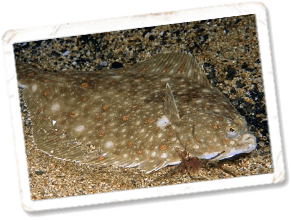
Plaice
‘Pleuronectes platessa’ is the most important commercial flatfish in Europe. They are able to change colour to match their surroundings and so can be very difficult to spot as they are expertly camouflaged. A very remarkable change occurs as the fish develops from a juvenile into a mature fish whereby the left eye moves around the head to the right side of the fish. This then enables the fish to lie totally flat against the sea bed.
‘Pleuronectes platessa’ is the most important commercial flatfish in Europe. They are able to change colour to match their surroundings and so can be very difficult to spot as they are expertly camouflaged. A very remarkable change occurs as the fish develops from a juvenile into a mature fish whereby the left eye moves around the head to the right side of the fish. This then enables the fish to lie totally flat against the sea bed.
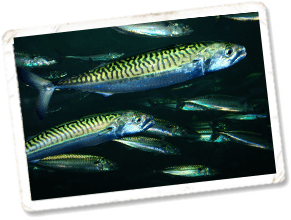
Mackerel
‘Scomber scombrus’ have dark wavy stripes on the upper part of the body are used as ‘schooling marks’. The fish are able to look at the vertical lines on adjacent fish and can then align themselves with the rest of the school and adjust their swimming speed. These schools can reach huge sizes, sometimes as long as 20 miles.
‘Scomber scombrus’ have dark wavy stripes on the upper part of the body are used as ‘schooling marks’. The fish are able to look at the vertical lines on adjacent fish and can then align themselves with the rest of the school and adjust their swimming speed. These schools can reach huge sizes, sometimes as long as 20 miles.
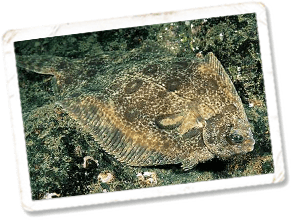
Lemon Sole
‘Microstomus kitt’ lives most often on stony sea floors. They eat many different small invertebrates, but their diet is mostly made up of worms. What is odd is that they seem to almost completely stop eating in the winter time. The lemon sole has a very small mouth, which is why its name contains the word Microstomus, which is Latin for small mouth. It’s English name however is a bit of a misnomer, as it is technically not a member of the sole family and it does not taste like lemon!
‘Microstomus kitt’ lives most often on stony sea floors. They eat many different small invertebrates, but their diet is mostly made up of worms. What is odd is that they seem to almost completely stop eating in the winter time. The lemon sole has a very small mouth, which is why its name contains the word Microstomus, which is Latin for small mouth. It’s English name however is a bit of a misnomer, as it is technically not a member of the sole family and it does not taste like lemon!
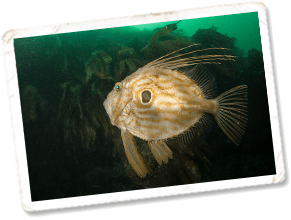
John Dory
‘Zeus faber’ are a predatory species and so feed on smaller fish. Whilst John Dory are not very good swimmers they have an extendable, tube-like mouth so they only have to get quite close to their prey before they shoot out their mouth and suck in the smaller fish. They have a large black spot on their side and this is thought to be a defensive strategy, as it fools predators into thinking they’re looking into the eye of a much bigger fish.
‘Zeus faber’ are a predatory species and so feed on smaller fish. Whilst John Dory are not very good swimmers they have an extendable, tube-like mouth so they only have to get quite close to their prey before they shoot out their mouth and suck in the smaller fish. They have a large black spot on their side and this is thought to be a defensive strategy, as it fools predators into thinking they’re looking into the eye of a much bigger fish.
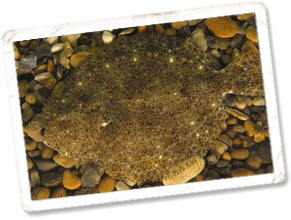
Brill
‘Scophthalmus rhombus’ is a species of flatfish that can be found in the northeast Atlantic, Baltic Sea and Mediterranean, usually in deeper waters. Like other species of flatfish, the brill is able to change its colour depending on the sea bed that it lies. It feeds on bottom dwelling fish and crustaceans.
‘Scophthalmus rhombus’ is a species of flatfish that can be found in the northeast Atlantic, Baltic Sea and Mediterranean, usually in deeper waters. Like other species of flatfish, the brill is able to change its colour depending on the sea bed that it lies. It feeds on bottom dwelling fish and crustaceans.

European Common Squid
‘Alloteuthis subulata’ is a relatively small squid species and doesn’t usually have a body that grows longer than 20cm. Like all species of squid, it has eight short arms and two much longer tentacles that are used for catching prey. They are most commonly found in British waters during the summer, due to their spawning migration. The spawning season happens in June and July. Their eggs are covered in gel and laid in strings, which are then attached to hard objects on the seabed.
‘Alloteuthis subulata’ is a relatively small squid species and doesn’t usually have a body that grows longer than 20cm. Like all species of squid, it has eight short arms and two much longer tentacles that are used for catching prey. They are most commonly found in British waters during the summer, due to their spawning migration. The spawning season happens in June and July. Their eggs are covered in gel and laid in strings, which are then attached to hard objects on the seabed.
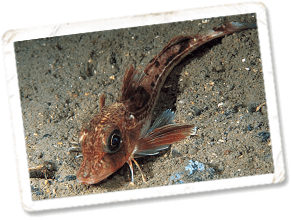
Grey Gurnard
‘Eutrigla gurnardus’ are a species of sea robin. This name stems from the large pectoral fins that they use to almost ‘fly’ through the water (like a robin). They have large armoured heads and their bodies are covered in spines to help protect themselves against predators. They have feelers under their heads which they use to ‘walk’ along the sea floor. This has led to an informal name of feeler fish due to these sensory organs that they walk on. Gurnards also hit their swim bladders with special muscles that enable them to make loud croaking and grunting noises. This is thought to be a method of communication between individuals.
‘Eutrigla gurnardus’ are a species of sea robin. This name stems from the large pectoral fins that they use to almost ‘fly’ through the water (like a robin). They have large armoured heads and their bodies are covered in spines to help protect themselves against predators. They have feelers under their heads which they use to ‘walk’ along the sea floor. This has led to an informal name of feeler fish due to these sensory organs that they walk on. Gurnards also hit their swim bladders with special muscles that enable them to make loud croaking and grunting noises. This is thought to be a method of communication between individuals.
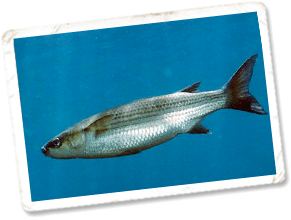
Grey Mullet
Both the thick-lipped grey mullet (Chelon labrosus) and the thin-lipped grey mullet (Chelon ramada) can be found in waters around the UK. They prefer to live in stiller water and so are often found in harbours, marinas, estuaries and sheltered coves/bays. Mullet can thrive in waters with a much lower salt concentration that would kill most other sea fish and they will often travel far up rivers in search of the calm waters they prefer.
Both the thick-lipped grey mullet (Chelon labrosus) and the thin-lipped grey mullet (Chelon ramada) can be found in waters around the UK. They prefer to live in stiller water and so are often found in harbours, marinas, estuaries and sheltered coves/bays. Mullet can thrive in waters with a much lower salt concentration that would kill most other sea fish and they will often travel far up rivers in search of the calm waters they prefer.
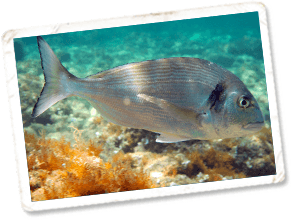
Gilthead Bream
‘Sparus aurata’ are a species of bream that can be found in sandy areas and sea grass beds. They don’t travel far from their established homes and when displaced they will return to their original territory. It is a mainly carnivorous species that feeds on molluscs (especially muscles) and crustaceans as they can easily crush their shells. Gilthead bream are what’s known as a protandrous hermaphrodite which means that all individuals are born male and at a certain point in their lives will change sex from male to female.
‘Sparus aurata’ are a species of bream that can be found in sandy areas and sea grass beds. They don’t travel far from their established homes and when displaced they will return to their original territory. It is a mainly carnivorous species that feeds on molluscs (especially muscles) and crustaceans as they can easily crush their shells. Gilthead bream are what’s known as a protandrous hermaphrodite which means that all individuals are born male and at a certain point in their lives will change sex from male to female.
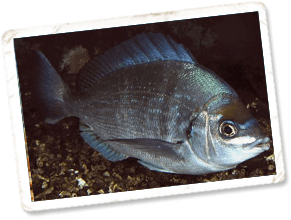
Black Seabream
‘Spondyliosoma cantharus’ is a species that is most commonly found in areas with rocky or sandy bottoms and seagrass beds up to about 300m in depth (mainly between 10m and 100m). Juveniles usually live in shallower water and tend to remain further inshore until about two or three years of age. Black seabream are protogynous hermaphrodites which means that they are born female and will change to being male at a certain point in their lives.
‘Spondyliosoma cantharus’ is a species that is most commonly found in areas with rocky or sandy bottoms and seagrass beds up to about 300m in depth (mainly between 10m and 100m). Juveniles usually live in shallower water and tend to remain further inshore until about two or three years of age. Black seabream are protogynous hermaphrodites which means that they are born female and will change to being male at a certain point in their lives.
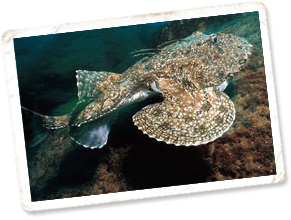
Anglerfish
‘Lophius piscatorius’ usually lives at a depth of about 550m and sometimes reaches depths of 2,000m. They have large flat heads and long filaments along the middle of their heads which are actually modified spines. The longest one of these filaments can be moved in any direction and has a fleshy lure, called a lappet, at the end of it. This attracts smaller fish towards the anglerfish so that it can then strike and seize them in their huge jaws.
‘Lophius piscatorius’ usually lives at a depth of about 550m and sometimes reaches depths of 2,000m. They have large flat heads and long filaments along the middle of their heads which are actually modified spines. The longest one of these filaments can be moved in any direction and has a fleshy lure, called a lappet, at the end of it. This attracts smaller fish towards the anglerfish so that it can then strike and seize them in their huge jaws.
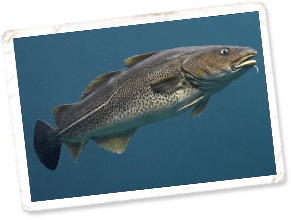
Cod
‘Gadus morhua’ are found all around the UK, but as they are a cold-water species they tend to be more common the autumn and winter. They have insatiable appetites and will eat almost anything they can find including worms, prawns, octopus, lobsters, crabs and almost anything else that they come across. They also sometimes actively hunt other smaller fish. As fisheries have become more efficient at catching cod, overfishing has caused stocks of cod to collapse.
‘Gadus morhua’ are found all around the UK, but as they are a cold-water species they tend to be more common the autumn and winter. They have insatiable appetites and will eat almost anything they can find including worms, prawns, octopus, lobsters, crabs and almost anything else that they come across. They also sometimes actively hunt other smaller fish. As fisheries have become more efficient at catching cod, overfishing has caused stocks of cod to collapse.

